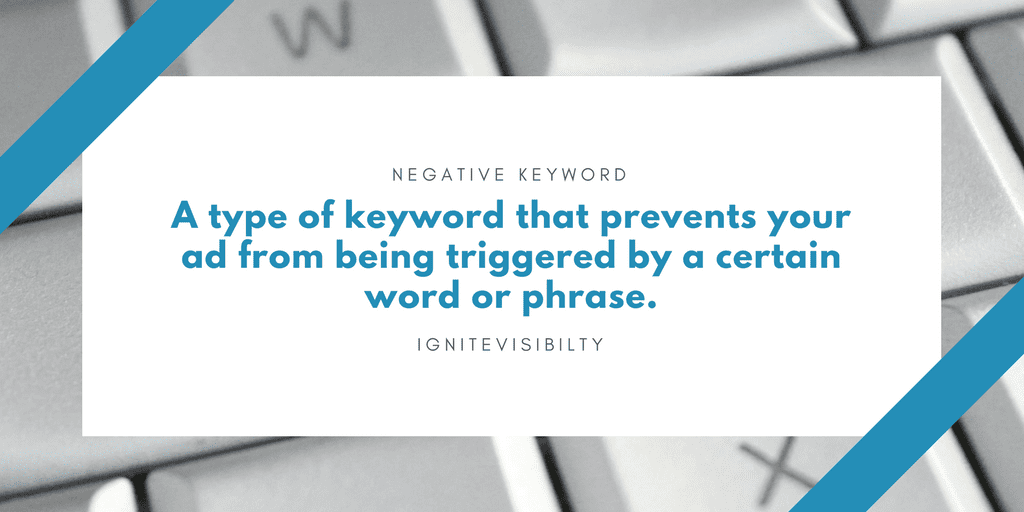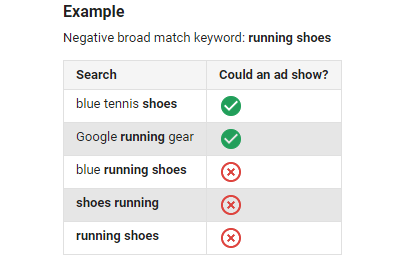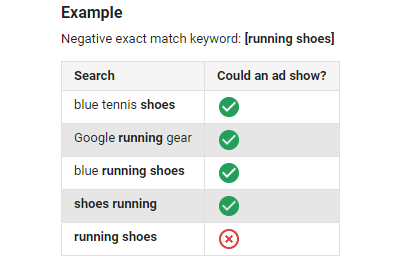Are you using negative keywords?
You probably are, even if you don’t know it.
But you may not be using them as effectively as possible. In this article, I’ll walk you through a few of my tricks to finding the right negative keywords for your brand.
What We’ll Cover:
- What negative keywords are
- Types of negative keywords:
- Tips for choosing match type
- How to find negative keywords:
- How to add negative keywords to Google Ads
- Campaign vs. Group level negative keywords
- FAQs
Don’t let the name fool you. Negative keywords can do wonders for your campaign.
But in all the fuss to collect the best positive keywords they can, marketers often overlook the benefits of their negative counterpart.
What are Google Ads Negative Keywords?
Ad campaigns can’t run effectively without keywords. They’re the bread to your ad’s butter, if you will.
A well-rounded list of keywords can do wonders for your campaign, no question.
The same goes for negative keywords.
These are search terms and phrases you don’t want your ad to show for. So, anyone searching for a term you’ve marked as negative won’t be shown your ad.
For example, if you run a high-end boutique clothing store, you may not want to show for a search query that includes “cheap jeans.” Signal it as a negative keyword, and anyone searching for those cheap jeans won’t find an ad for your boutique.
This plays a major role in marketing targeting.
Not only will selecting the right negative keywords help you better target your audience for your ad campaign, it can have a major effect on your overall ROI (in a good way, of course.) Beyond that, it will reduce the number of unnecessary clicks and costs.
On Google’s Display Network, your ad will be less likely to show on site that contains content matching your negative keyword.
Types of Negative Keywords
Keywords come in a few different sizes: broad, exact, or phrase match.
The same goes for each Google negative keyword. But the Big G warns that are a few key differences, the biggest being that negative keywords don’t automatically include variations.
That means different spellings, slang words, synonyms, misspellings, and plural or singular forms need to be included as separate words if you want them excluded.
Negative Broad Match
This is your default in pay-per-click search campaigns unless you specify otherwise.
Negative broad match means your ad will not show for a search that contains all your negative keywords, even if they’re entered in a different order.
Google gives the example of running shoes.
If “running shoes” is your negative broad match keyword, phrases like “blue running shoes” and “shoes running” will not show in results.
However, your ad could still show for searches like “blue tennis shoes” or “running gear” because it includes words you didn’t list as negative.
This is where it’s extremely important to pay attention to all the variations of your keywords and include different spellings and synonyms.
When entering negative broad match, you enter it in just as you would type it, no extra characters needed to signify it’s broad match.
Example: running shoes.
Negative Phrase Match
Negative phrase match stops your ads from showing in searches that contain the terms you entered in the exact order.
There can be additional words in the search query, as long as your exact phrase is included.
Back to the “running shoes” example. “Blue running shoes” and “running shoes” still won’t show, but “shoes running” will, because it’s not in the exact order you specified.
To enter negative phrase match, include quotes around the phrase.
Example: “running shoes”
Negative Exact Match
With exact match, the search query must exactly match the keywords you entered. No additional words can be included in the query.
So, for the “running shoes” example, only a search for “running shoes” will exclude your ad. Any other variations, including “blue running shoes” or “best running shoes” will not stop your ad from appearing in search results.
Important note here: negative keywords are always considered exact match for display and video campaigns, and you will not be able to change the match type.
Negative exact match keywords are entered using brackets.
Example: [running shoes]
Tips for Choosing Your Negative Keyword Match Type
Be careful when choosing your match type, and take the time to consider the ramifications of each.
For example, if you’re running an ad for “gluten free pizza” and don’t want your ad to show for queries such as “free gluten free pizza” or “gluten free pizza for free,” entering “free” as a negative broad match keyword will exclude all relevant queries, including “gluten free pizza.”
Instead, you would want to consider adding the whole search phrase you want excluded as an exact or phrase match.
Also keep in mind that it’s best to check for any conflicting keywords. In some cases, you could end up entering a negative keyword that you’re also bidding on.
As in the example above, if you’re bidding on the keyword “gluten free” but also include free as a negative keyword, you would block your ad from appearing in relevant searches (and waste some of your valuable budget).
Google also outlines the following to keep in mind while choosing negative keywords:
- Choose them carefully. If you use too many negative keywords your ads will likely reach fewer customers
- Your ad can still show on searches or pages that include close variations of your negative keyword terms
- Your ad could still show for a search query that’s more than 10 words, if your negative keyword appears after the 10th word
How to Find Google Ads Negative Keywords
Selecting negative keywords is a similar process to selecting positive ones. This means that yes, it can be daunting and time-consuming.
But if you know where to look and what tools can help, you’ll cut your legwork in half.
Google recommends starting broad. Think about terms that are similar to your keywords, but really apply to a different product.
So if you’re advertising that gluten free pizza, you might start with negative keywords like “dairy free pizza.”
But don’t stop there. Brainstorming is a good start, but to cover all your negative keyword ground, you’ll need a few tools to help.
Use Google’s Search Term Report
If you want to know how to find negative keywords, Google’s Search Term Report will point you in the right direction. It’s a tool that shows you actual terms and queries people searched for that have triggered your ad to show.
Use that info to turn the tool into a negative keyword finder. You’ll not only be able to see what keywords have been most effective, but which keywords people are searching for that aren’t related to your product.
To access the report, you’ll sign into your Ads account and click the Keywords tab.
Next, you’ll select the checkbox next to the keywords you want to run the search for and click the Search Terms button.
It will take you to the search terms tab; to see all the details, click “show all”.
If you see any you want to add as negative, click the “add as negative keyword” button.
This should be done to any terms or phrases you find that are irrelevant to your product.
For example, if you’re a photographer who focuses solely on weddings but notice you’ve been appearing in search results for “family portraits,” you would likely want to add that phrase to your negative keywords list.
It can also help you weed out positive keywords that are under-performing.
In your report, you can filter your results by the terms that yield the highest impressions and click-through-rates. If you notice any terms you initially added as keywords aren’t yielding the returns you had hoped, you can add them as negative and focus instead on the keywords that perform the best.
Use Google’s Keyword Planner
You can also use Google’s Keyword Planner as a negative keyword finder.
To access the tool, go to your Google Ads account and navigate to the Keyword Planner.
There, you’ll enter a keyword (or keywords) you would like to target.
Once the results are pulled, you’ll be shown a list of related terms and phrases. Traditionally, these are meant to show you relevant keywords to include in your list.
But it can just as easily help you add to your negative keywords by showing terms you know aren’t relevant to your business.
Use a Thesaurus
When in doubt, check in with the pro.
Because negative keywords don’t pull synonyms, a thesaurus can be a valuable resource when it comes to finding different variations of a word you definitely don’t want to show up for.
Take the word “used.” If you sell new items, that’s likely a good candidate for your negative keywords list. Because it’s a pretty major one, a look through a thesaurus is a sure way to cover your bases and uncover similar words like “refurbished.”
Of course, you don’t have to check every negative keyword you plan to add. But it can certainly help eliminate your major negatives and similar variations, especially on days when your brain’s already overloaded.
Note: as this is the digital age, don’t waste energy skimming through the hardback version – simply head to thesaurus.com.
Consult the Standard List of Negative Keywords
Here’s something pretty cool: in some cases, your peers have done the work for you.
There are some words that are universally bad for pretty much every campaign, and it’s often a great place to start when building your own list.
These lists are generally pretty extensive, albeit general.
A few good ones include:
- KoMarketing’s 200+ Negative Keywords to Consider for B2B PPC
- PPC Hero’s Super-Duper List of General Negative Keywords (download)
- Techywyse 75 Effective Negative Keywords to Include in All AdWords Campaigns
Keep in mind, these lists are references only. Always look them over before entering to make sure they don’t include any keywords you do want to rank for.
Check Google’s Search Assist
Another handy keyword checker is search assist.
No fancy setup required here; simply launch Google and start to enter your highest traffic keywords. As you type, Google will automatically show you possible search queries in its drop-down menu.
The results, as always, may surprise you.
These are top searches in Google that include those keywords, and if you find any that do not relate to your campaign, exclude them by adding those phrases to your negative list.
Similarly, taking a look at one result on the first page will give you a good idea of what Google sees as relevant results. If they don’t match your campaign, send them to your negative list.
Use an Online Negative Keyword Tool
Google isn’t the only place to find negative keyword information.
Wordstream offers a free Negative Keyword tool to help you quickly identify irrelevant search phrases.
When I typed in “gluten free pizza,” it returned results including “gluten free pizza recipes” and “gluten free vegan pizza”. If I’m solely selling pizza, a search for recipes won’t do me any good. The same goes if vegan pizza isn’t on the menu.
A similar tool is ubersuggest.io. While this one isn’t made specifically for negative keywords, it can be used as easily as Google’s Keyword Tool to find keywords that don’t quite match what you’re selling.
Use Normal Keyword Research
You probably already do keyword research to learn about keywords you want to use in your content marketing and PPC campaigns. But you can also use keyword research to uncover negative keywords.
How? By simply looking at the keywords that your favorite tool spits out.
Let’s say you use SEMRush for keyword research. You plug in a bland search term and the tool delivers a report with hundreds of related keywords.
On a normal day, you’ll go through the report looking for keyword opportunities. You should also use the report to look for negative keywords.
You might come across some search terms, for example, that you think people will use to find your ad. However, you realize that the search term isn’t relevant to the product or service you’re selling.
In that case, add it to your negative keywords list.
Rinse and repeat. Go through your related keywords thoroughly to weed out terms that people might use to find your ad even if they’re not looking for what you’re selling.
Remember: when searching for negative keywords, you also want to pay attention to search terms that don’t get a whole lot of clicks every month. If you block all of those, that can save you a lot of money in clicks that will never convert.
How to Add Google Ads Negative Keywords to Ads
Once you have a solid list of keywords to exclude, the next step is adding them to your AdWords account.
First, you’ll want to add and organize all your negative keywords in a list. With a list, you’ll be able to apply the same keywords to multiple campaigns rather than manually add them to each.
Each list can contain up to 5,000 negative keywords, and you’re allowed 20 lists per account.
Google recommends separating the lists by themes or products, so you’ll have a better handle on which applies to which campaign.
To create the list, sign in to your account and click the Campaigns tab. Then select the Shared Library link, and afterward click Campaign Negative Keywords.

how to add negative keywords
Click +List, give the list a name, and begin entering your keywords.
After you have saved the list, navigate back to the Campaign Negative Keywords page to apply it to your campaign. There you can choose to apply it to multiple campaigns or just one.

creating a negative keyword list
Campaign vs. Group Level Negative Keywords
Another thing to keep in mind as you add negative keywords is the level you want to apply them to.
You can add them to either the campaign or group level.
Using them at the campaign level will apply them to all ad groups in that campaign, which means that none of your ads will show for those particular keywords.
At the group level, your negative keywords will only be excluded from that group, not the campaign as a whole.
Most negative keywords are added at the campaign level, which is a good practice in theory. But group level negatives shouldn’t be ignored. They can help control which ads are (or aren’t) appearing for certain terms and further ensure your traffic is going to the correct ad.
Don’t Forget to Review Your Negative Keywords
Once you’ve created a list of negatives, it’s always a good practice to go back and review it from time to time.
This especially important to ensure you aren’t inadvertently blocking traffic that is now beneficial.
For example, maybe when you created a negative keyword list your clothing store didn’t sell men’s items. But six months later, your store’s expanded. If you excluded mens clothing from your keywords and didn’t update it later, you could be missing out on valuable traffic.
Factors like inventory, location, etc. are subject to change over time, so make sure your keywords change with it.
Google Ads Negative Keywords FAQs
1. What are the most commonly used negative keywords?
There is a list of commonly used negative keywords that might be useful for you to include in your next ad campaign. Here they are:
- Free
- Cheap
- Nude
- Naked
- YouTube
- Craigslist
- EBay
2. What are some negative keywords that can keep jobseekers from finding my ads?
To eliminate jobseekers from your target audience, you can include the following negative keywords in your ad campaign:
- Hire
- Hiring
- Employment
- Employer
- Employers
- Job
- Occupation
- Full time
- Part time
- Work
- Resume
- Recruiter
- Salary
The list goes on, but you probably get the idea by now.
3. What are some negative keywords to keep education-seekers from finding my ads?
If your company does not offer services or products that help people further their education, you can use the following negative keywords to eliminate these folks from your target audience:
- Training
- Learn
- Classes
- School
- University
- Tutorial
- Couse
- Textbook
- Books
And the list goes on.
4. Are there any negative keywords that can reduce the amount of “window-shoppers” finding my ad?
Yes! To avoid getting a bunch of visitors who are only there to browse, you can include the following negative keywords:
- Review
- Rating
- Opinion
- Article
- Info
- Information
- Pics
- Photos
- How to
- How do I
Wrapping Up Negative Keywords
When it comes to PPC, positive keywords are just one part of the game.
Negative keywords will have an incredible impact on your campaign as well. And though Google does a great job of filtering and applying your ad, it’s always best to give it a little help.
Providing negative keywords is a surefire way to do that, and improve your ad’s relevancy and ROI in the process.





